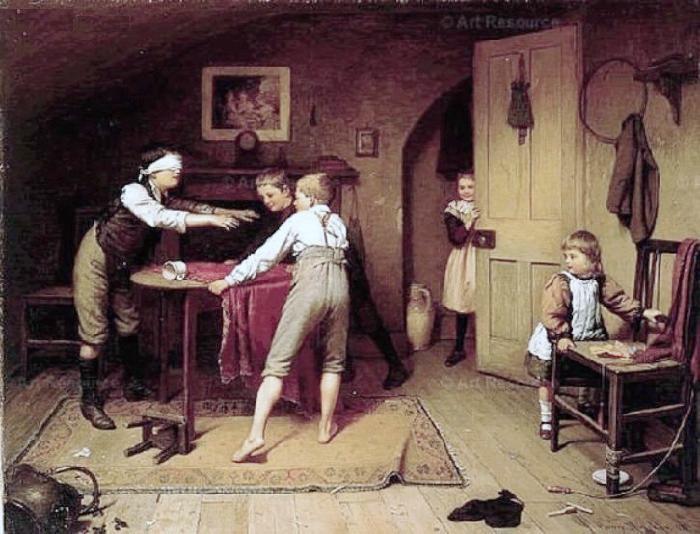
English Outdoor Games: Blind Man's Buff

Figure 1.--This painting by English genre painter Harry Booker (1848-1940) shows boys playing blind man's buff at home in 1898. We do not know much about book, but he left a huge number of images showing English children at play and other chilhood activitied. They were mostly painted in the 1880s-90s.
|
|
Blind-man's buff was a kind of tag game of ancient origins. We are not sure when if first appeared in England., but it has been polayed for centuries. We do not have any early English images of blimdman's buff. We do have have Tudor references (16th century). The game was played in England during the Tudor period. There are references to its recreation by Henry VIII's courtiers. Here it was an adult game. Thgere were also Stuart (17th century) references. It was still an adult game. The diarist Samuel Pepys reported a game played by his wife and some lady friends (1664). We note beautiful French roico images of beautidul, elkegantly attired French women playing blkindman's bufd. We think the same was true of Engkand. This changed after the French Revolutiin (1789). It transitioned to a children game, not longer played by beautidully dressed cour ladies. In the most commonly known version one player is blindfolded (or hooded in some countries) and, after being turned around a few times for disorientation, has to catch one of the others. The blindfolded player is usually taunted, struck and poked with sticks, for the general amusement. This is the version of the game that crossed the Atlantic to America. by the Victorianera thge game had become a popular middlke-class parlor game for adults as well as a playground and indoor game. (It could not be palayed on street sidewalks because of the safty factor.) We start bhearing different names, including 'Hoodwink blind' and 'blind man's bluff'. By the 20th century it was mostly a children's indoor game. At least most of the images we have found depict the game being played indoors. The Harry Booker image here is a good example (figure 1). A British reader tells us, "This is an interesting theme. I never thought there was such an history around this game. The painting brought back memories of playing this game. Placing obsticles in the way of the child who was on. Another trick was to touch the person making the child turn around so causing who ever was blindfolded to be disoriented. Also diliberatly being caught to be the next one on and then wishing one had not done it. It was a game played at birthday parties or on days when it was too cold or wet to play out."
HBC

Navigate the Boys' Historical Clothing Web Site:
[Return to the Main English outdoor play page]
[Return to the Main blind man's buff page]
[Introduction]
[Activities]
[Biographies]
[Chronology]
[Clothing styles]
[Countries]
[Bibliographies]
[Contributions]
[FAQs]
[Glossary]
[Images]
[Links]
[Registration]
[Tools]
[Boys' Clothing Home]
Created: 6:44 AM 11/3/2019
Last updated: 12:10 AM 11/4/2019



